Cute-SCIDAR at Paranal, an IAC-ESO collaboration for E-ELT site characterization
Authors:
Gianluca Lombardi (1,2,3), Héctor Vázquez Ramió (4), Marcos Reyes (4), José Miguel Delgado (4), Jesús J. Fuensalida (4), Frederic Derie (1), Julio Navarrete (1), Marc Sarazin (1)
-
(1)
-
European Southern Observatory
-
(2)
-
National Institute for Astrophysics – Bologna Astronomical Observatory
-
(3)
-
University of Bologna – Department of Astronomy
-
(4)
-
Instituto de Astrofísica de Canarias
Summary
The site characterization campaign for the European Extremely Large Telescope pays much attention to the study of the vertical distribution of the atmospheric turbulence. Among the available profiling methods, the Generalized SCIDAR (SCIntillation Detection and Ranging) technique is the most comprehensive, but needs apertures above 1 m diameter. A modern application, the Cute-SCIDAR was developed by IAC and a copy was installed at the focus of one of the VLTI Auxiliary Telescopes (AT) with European FP6 funding. The aim is to compare the quality of the Canaries and Northern Chile sites with respect to parameters of importance for Adaptive Optics and to estimate the performance of full vs. partial correction modes.
Profiling the atmosphere
The main source of turbulence in the atmosphere is of a mechanical nature. When hitting thermally stratified layers with a strong vertical temperature gradient, the mechanically turbulent eddies trigger thermal turbulence which is felt by propagating light as variations in the index of refraction. This perturbation of the incoming optical wavefront is usually called “optical turbulence”. It is characterized by the profile of the index of refraction fluctuations (Cn2(h)) and its integral values (seeing or wavefront radius of coherence, coherence time and isoplanatic angle). Pioneering work was conducted by atmospheric physicists in the US, Italy and France during the 70’s, on profiling the atmospheric optical turbulence with microthermal sensors attached to balloons. Already in the 80’s, profiling the atmosphere had become an issue for astronomy: the first SCIDAR measurements in Chile took place at La Silla in 1986, later at Paranal in the frame of the site survey for the VLT (Fuchs et al. 1998) and similarly at La Palma (Vernin & Muñoz-Tuñon 1992). Nowadays, because the future Extremely Large Telescopes (ELTs) are foreseen to operate a large fraction of the time with Adaptive Optics (AO) atmospheric correction, all site characterization programmes now include some type of profiler from among those listed in Table 1.
Table 1 Techniques to Measure the Turbulence Profile of the Atmosphere
|
OPTICAL |
Method (nighttime) |
Range (typical) |
Resolution (typical) |
Year reaching reliability (calibrated output)/PI |
|
SCIDAR |
0-20000 m |
300 m |
1986/J. Vernin |
|
MASS |
500-20000 m |
height/2 |
2004/A. Tokovinin |
|
SLODAR (Ground Layer mode) |
0-1000 m |
60m |
2006/R. Wilson |
|
LuSci |
0-200 m |
height/2 |
2007/A. Tokovinin |
|
NON OPTICAL |
SODAR (acoustic) |
30-800 m |
30-60 m |
2006/T. Travouillon |
|
Microthermal (balloon) |
0-20000 m |
2 m |
1980/J. Vernin |
|
Microthermal (mast) |
0-30m |
Local |
1980/J. Vernin |
In the generalized mode (Tallon 1989), SCIDAR is sensitive over the whole atmospheric column. Provided one can remove the local contribution of the telescope enclosure, SCIDAR is the perfect tool for characterizing existing observatories and for supporting operation of AO assisted astronomical observations.
Design Study Activity for European ELT Site Characterization
The Instituto de Astrofísica de Canarias (IAC), the University of Nice and ESO have joined together in the frame of the EU-funded FP6 ELT Design Study (WP12000) to study in detail, and in a coherent manner, four of the potential candidate sites for the E-ELT. WP12000 is chaired by Jean Vernin (LUAN, Univ. Nice) with Casiana Muñoz-Tuñón (IAC) and Marc Sarazin (ESO) as deputies. In addition to the deployment of the now standard MASS-DIMM devices on all four sites (Argentina, La Palma, Morroco and Paranal North), the group proposed to install at Paranal a copy of the Cute-SCIDAR, which has been in operation by the IAC for the La Palma and Izaña observatories (Fuensalida et al. 2004).
Commissioning
The upgraded version of Cute-SCIDAR instrument for Paranal has been developed by IAC. The new performances are to provide the temporal evolution of turbulence profiles in real time with and without dome seeing contribution, and the remote control of the entire instrument.
The VLTI Auxiliary Telescope 4 (AT4) was just commissioned when negotiations started with Paranal Observatory. The timing was good because one of the adaptors built for PRIMA (see Figure 1) was available with the field derotation function needed for the SCIDAR. It was agreed that Paranal engineering would park the Cute-SCIDAR at the AT4 station whenever it would not be needed for other purposes. The assembly of the Cute-SCIDAR into PRIMA Remote Operation System (ROS) was performed at IAC. The IACSCIDAR team, in collaboration with ESO site testing and VLTI groups, commissioned the instrument using the Auxiliary Telescope 4 (AT4) in July 2007. After solving some technical problems, the Cute-SCIDAR reached full accuracy in November (Figure 2) and a total of 20 nights of data have been collected to date.
Operations
The Cute-SCIDAR is operated remotely using the User PC placed in the VISTA compartment in the Control Room. The User PC is connected to the Acquisition and Control PC's in the instrument via an optical fiber link. The instrument is mounted at AT4 that is positioned at VLTI J2 station during the run. During operations, the instrument is pointed at a double star target transiting between -2 hrs and +2 hrs with respect to the meridian. Typically we observe stars brighter than 5.0 mag in V-band. The more the double star is separated, the better is the resolution of the instrument. For this reason the minimum allowed separation is 7.0 arcsec. We can also affirm limitations on the difference in magnitude Δm between the two binary components, so the maximum allowed Δm is ∼1.0 mag. In the southern hemisphere, at the latitude of Paranal, there is a limited number of binary systems of this kind, so we can observe only two or three targets each night for about 8 consecutive hours.
The Graphical Unit Interface runs on the User PC and controls the totality of the movements (Rotation Unit, Field Diaphragm, X-Y-Z stages) and functionality (power supply, acquisition, flat-fielding, etc.) of the instrument. In Figure 3 we show a screen-shot of the GUI taken during observations.
Results and applications
During night acquisition, data are reduced in real time, giving the possibility of a full and immediate understanding of the evolution of the atmospheric turbulence at different altitudes above Paranal. Data are stored every 25 seconds, and the data reduction software produces a graphical summary of the evolution of the turbulence every minute (see Figure 4). At any time we thus have the possibility of knowing both the chronology and the instantaneous value of several parameters, such as seeing, isoplanatic angle and power of the turbulence at fixed layers. This is a powerful tool for those observing techniques that require flexible calibration and scheduling, such as Multi-Conjugate or Ground Layer Adaptive Optics.
At the end of each night we compare the acquired seeing data with simultaneous synoptical parameters such as wind speed and wind direction in order to have a brief and immediate correlation between observing and weather conditions on the site.
Up to now we have collected 20 nights of observations that correspond to thousands of samples of atmospheric turbulence profiles. In the near future we will analyze those data in order to build the typical turbulence profile at Paranal during the monitoring period as well as a precise estimation of the astroclimatic parameters -seeing, wavefront coherence time, isoplanatic angle and relative contribution of different turbulent layers to the total turbulence on the site. It is of course of interest to explore further the seasonal variations as well as the dependence on the jet stream. A larger database would be needed and we are currently exploring possible solutions to maintain SCIDAR online after PRIMA arrival.
Bibliography
Fuchs A., Tallon M. & Vernin J. 1998, PASP, 110, 86
Fuensalida J. J., Delgado J. M., García-Lorenzo B., et al. 2004, in Second Workshop on Extremely Large Telescopes, Proc SPIE 5382, 643
Tallon M. 1989, PhD thesis, Université de Nice, Nice-France
Vernin & Muñoz-Tuñon 1992, A&A, 257, 811
Figure Captions
Figure 1: Preparation for Cute-SCIDAR integration: lifting the ROS interface into one of the VLTI stations for the optical alignment of the
PRIMA derotator at the focus of AT4
Figure 2: The Cute-SCIDAR commissioning team at Paranal in November 2007.
Figure 3: The Cute-SCIDAR Graphical Unit Interface.
Figure 4: The standard output of the data reduction software showing the real-time evolution of the turbulence profile.
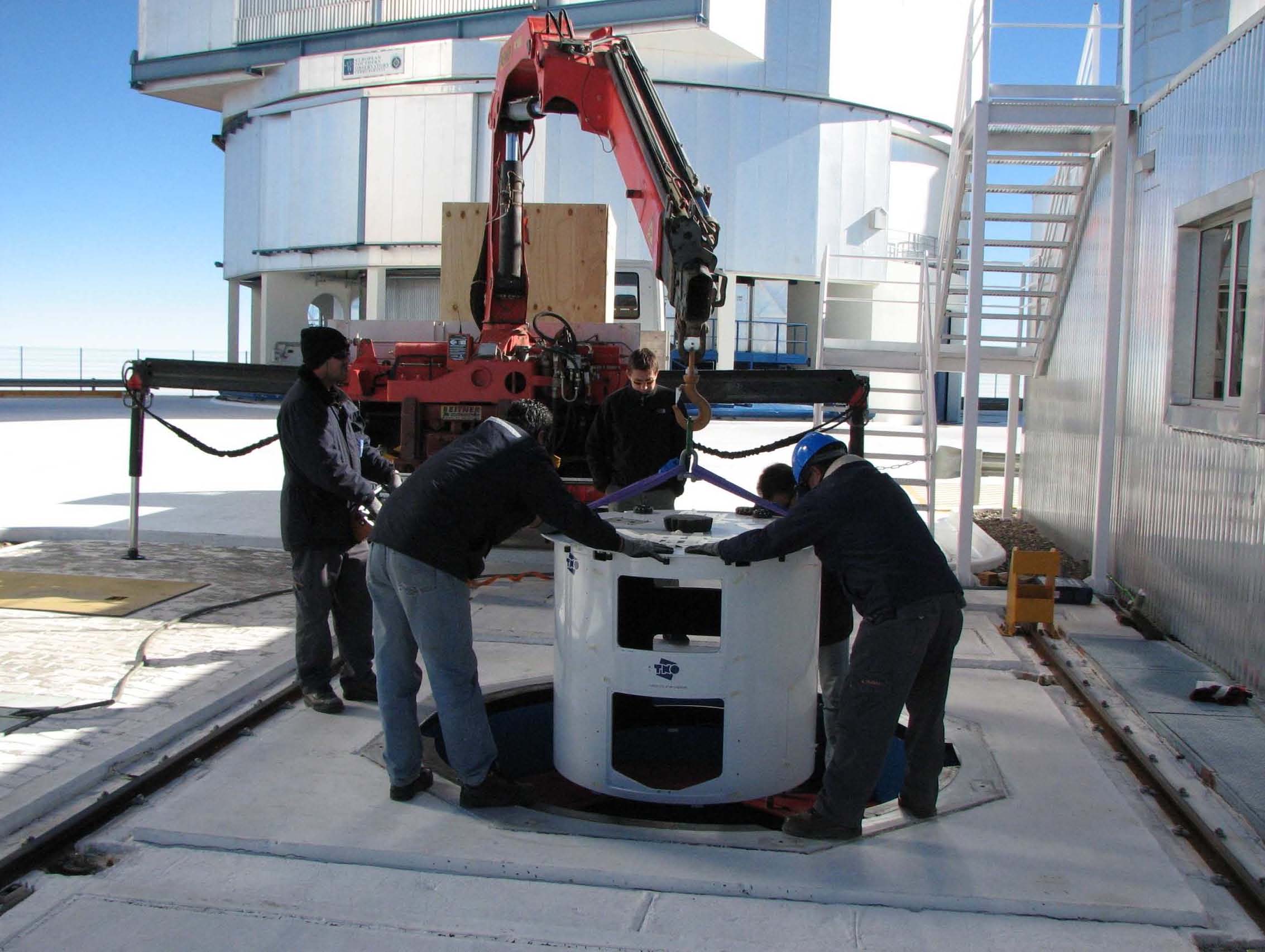
Fig.1
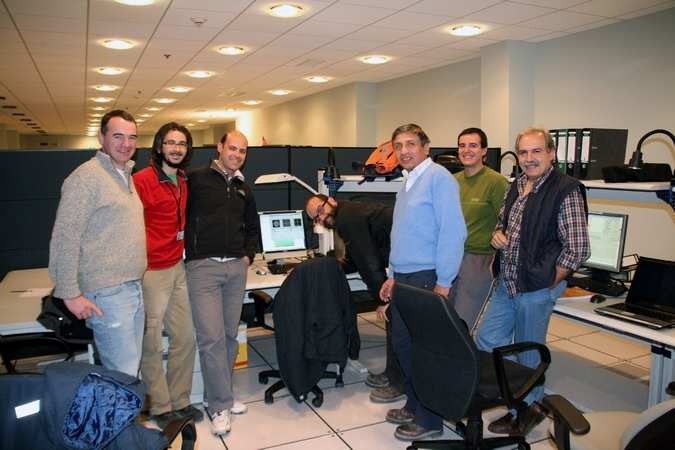
Fig.2 Fig. 3
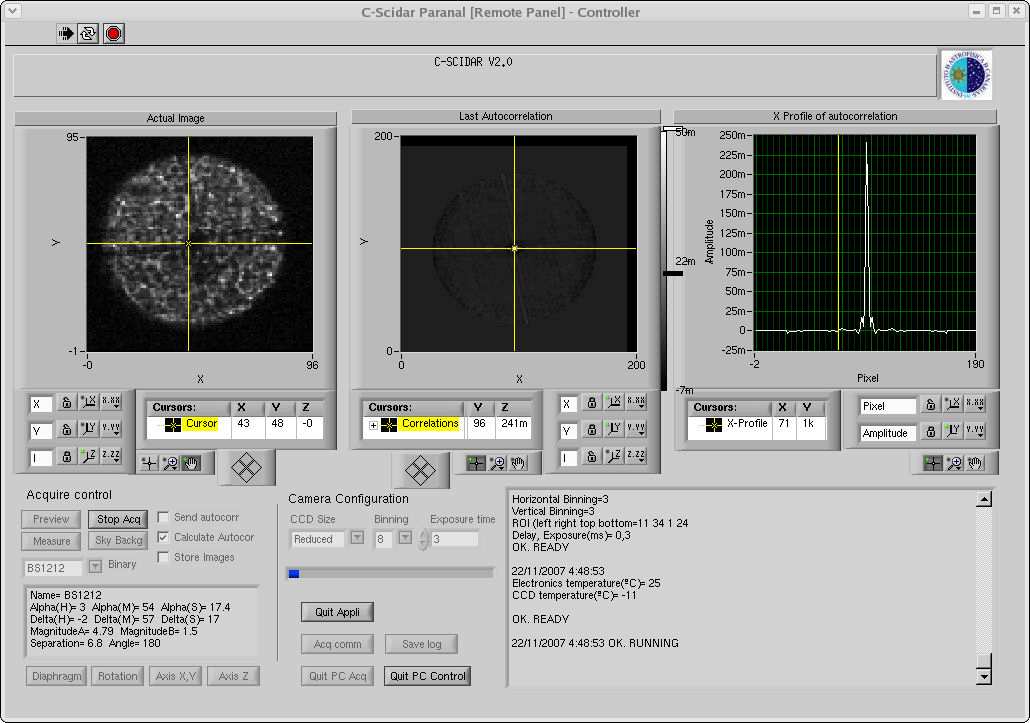
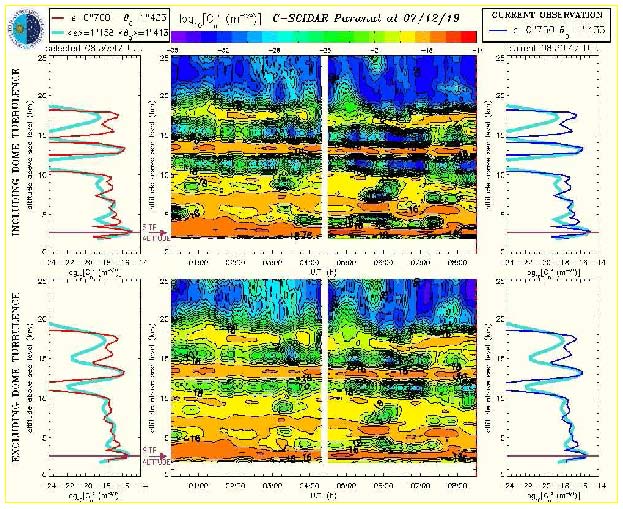
Fig.4
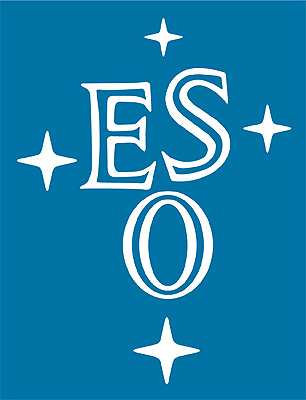
ESO PARANAL CUTE-SCIDAR
|
UT |
|
|
STAR |
|
|
AR |
|
|
DEC |
|
|
MAG 1ST |
|
|
ΔMAG |
|
|
SEP. |
|
|
TEXP |
|
|
CONJ.PL. |
|
|
00:30 – 01:45 |
BS8793 |
23 07 14.6 |
-50 41 11.0 |
5.83 |
0.8 |
|
8″.5 |
3 MS |
2 KM |
|
02:50 – 05:50 |
BS0897 |
02 58 15.6 |
-40 18 17.0 |
3.20 |
1.1 |
|
8″.3 |
1 MS |
2 KM |
|
06:15 – 08:15 |
BS1563 |
04 50 55.1 |
-53 27 41.0 |
5.61 |
0.8 |
|
12″.3 |
2 MS |
2 KM |


ESO PARANAL CUTE-SCIDAR
|
UT |
|
|
STAR |
|
|
AR |
|
|
DEC |
|
|
MAG 1ST |
|
|
ΔMAG |
|
|
SEP. |
|
|
TEXP |
|
|
CONJ.PL. |
|
|
01:59 – 06:10 |
BS0897 |
02 58 15.6 |
-40 18 17.0 |
3.20 |
1.1 |
|
8″.3 |
1 MS |
2 KM |
|
06:28 – 08:19 |
BS1563 |
04 50 55.1 |
-53 27 41.0 |
5.61 |
0.8 |
|
12″.3 |
2 MS |
2 KM |


ESO PARANAL CUTE-SCIDAR
|
UT |
|
|
STAR |
|
|
AR |
|
|
DEC |
|
|
MAG 1ST |
|
|
ΔMAG |
|
|
SEP. |
|
|
TEXP |
|
|
CONJ.PL. |
|
|
00:50 – 02:15 |
BS8793 |
23 07 14.6 |
-50 41 11.0 |
5.83 |
0.8 |
|
8″.5 |
3 MS |
2 KM |
|
02:35 – 06:00 |
BS0897 |
02 58 15.6 |
-40 18 17.0 |
3.20 |
1.1 |
|
8″.3 |
1 MS |
2 KM |
|
06:20 – 08:00 |
BS1563 |
04 50 55.1 |
-53 27 41.0 |
5.61 |
0.8 |
|
12″.3 |
2 MS |
2 KM |


ESO PARANAL CUTE-SCIDAR
|
UT |
|
|
STAR |
|
|
AR |
|
|
DEC |
|
|
MAG 1ST |
|
|
ΔMAG |
|
|
SEP. |
|
|
TEXP |
|
|
CONJ.PL. |
|
|
00:15 – 02:15 |
BS8793 |
23 07 14.6 |
-50 41 11.0 |
5.83 |
0.8 |
|
8″.5 |
3 MS |
2 KM |
|
02:35 – 06:10 |
BS0897 |
02 58 15.6 |
-40 18 17.0 |
3.20 |
1.1 |
|
8″.3 |
1 MS |
2 KM |
|
06:25 – 08:05 |
BS1563 |
04 50 55.1 |
-53 27 41.0 |
5.61 |
0.8 |
|
12″.3 |
2 MS |
2 KM |


ESO PARANAL CUTE-SCIDAR
|
UT |
|
|
STAR |
|
|
AR |
|
|
DEC |
|
|
MAG 1ST |
|
|
ΔMAG |
|
|
SEP. |
|
|
TEXP |
|
|
CONJ.PL. |
|
|
01:00 – 02:10 |
BS8793 |
23 07 14.6 |
-50 41 11.0 |
5.83 |
0.8 |
|
8″.5 |
3 MS |
3 KM |
|
02:20 – 05:45 |
BS0897 |
02 58 15.6 |
-40 18 17.0 |
3.20 |
1.1 |
|
8″.3 |
1 MS |
3 KM |
|
05:59 – 08:15 |
BS1563 |
04 50 55.1 |
-53 27 41.0 |
5.61 |
0.8 |
|
12″.3 |
2 MS |
3 KM |


ESO PARANAL CUTE-SCIDAR
|
UT |
|
|
STAR |
|
|
AR |
|
|
DEC |
|
|
MAG 1ST |
|
|
ΔMAG |
|
|
SEP. |
|
|
TEXP |
|
|
CONJ.PL. |
|
|
00:00 – 01:54 |
BS8793 |
23 07 14.6 |
-50 41 11.0 |
5.83 |
0.8 |
|
8″.5 |
3 MS |
3 KM |
|
02:09 – 05:53 |
BS0897 |
02 58 15.6 |
-40 18 17.0 |
3.20 |
1.1 |
|
8″.3 |
1 MS |
3 KM |
|
06:09 – 07:45 |
BS1563 |
04 50 55.1 |
-53 27 41.0 |
5.61 |
0.8 |
|
12″.3 |
2 MS |
3 KM |
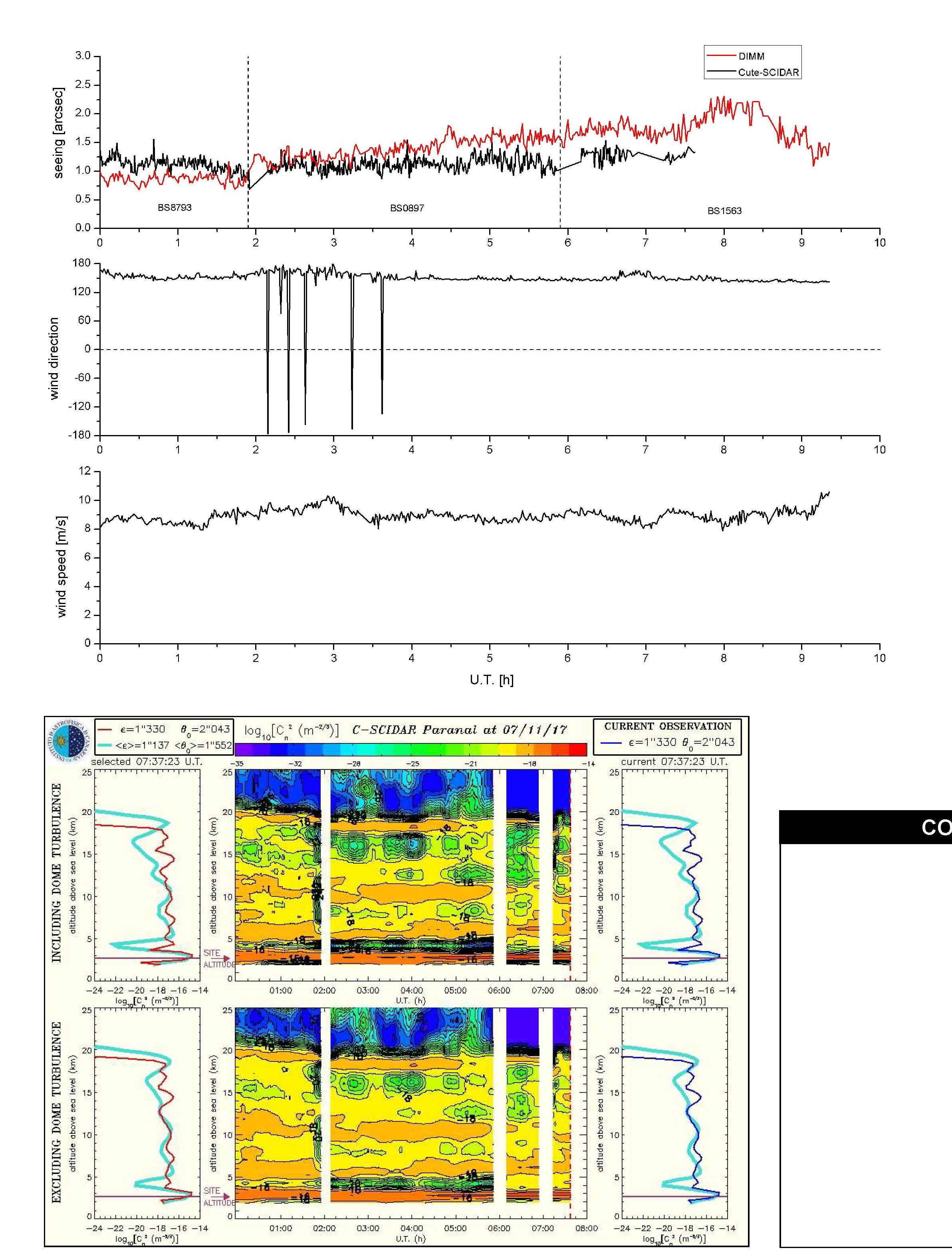


ESO PARANAL CUTE-SCIDAR
|
UT |
|
|
STAR |
|
|
AR |
|
|
DEC |
|
|
MAG 1ST |
|
|
ΔMAG |
|
|
SEP. |
|
|
TEXP |
|
|
CONJ.PL. |
|
|
00:54 – 02:10 |
BS9002 |
23 46 00.8 |
-18 40 41.0 |
5.29 |
1.0 |
|
6″.6 |
3 MS |
3 KM |
|
02:50 – 06:30 |
BS1212 |
03 54 17.4 |
-02 57 17.0 |
4.79 |
1.5 |
|
6″.8 |
3 MS |
3 KM |
|
06:48 – 08:32 |
BS2948 |
07 38 49.3 |
-26 48 07.0 |
4.50 |
0.2 |
|
9″.9 |
1 MS |
3 KM |
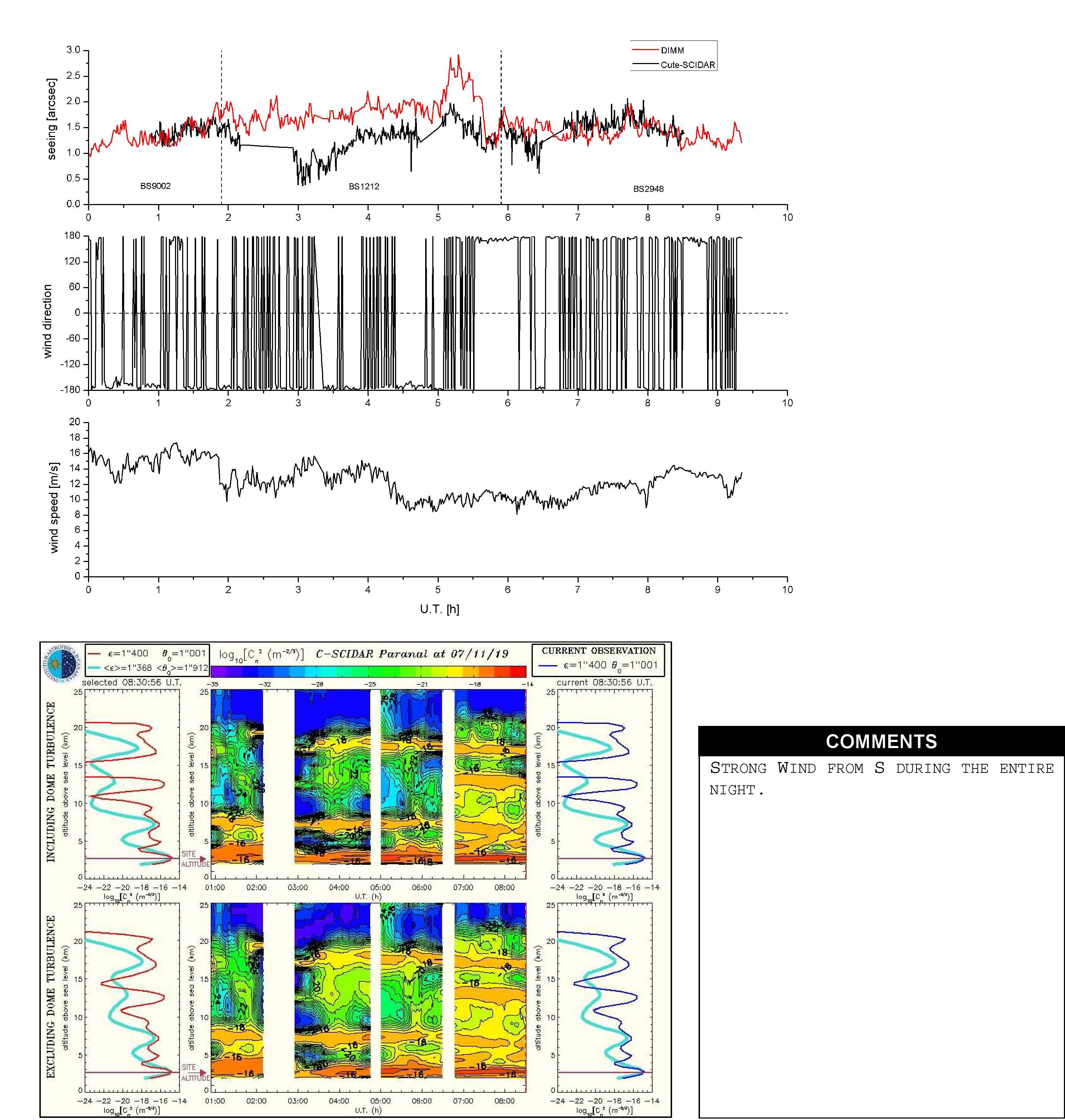

ESO PARANAL CUTE-SCIDAR
|
UT |
|
|
STAR |
|
|
AR |
|
|
DEC |
|
|
MAG 1ST |
|
|
ΔMAG |
|
|
SEP. |
|
|
TEXP |
|
|
CONJ.PL. |
|
|
05:30 – 06:36 |
BS1212 |
03 54 17.4 |
-02 57 17.0 |
4.79 |
1.5 |
|
6″.8 |
3 MS |
3 KM |
|
06:49 – 08:50 |
BS2948 |
07 38 49.3 |
-26 48 07.0 |
4.50 |
0.2 |
|
9″.9 |
1 MS |
3 KM |
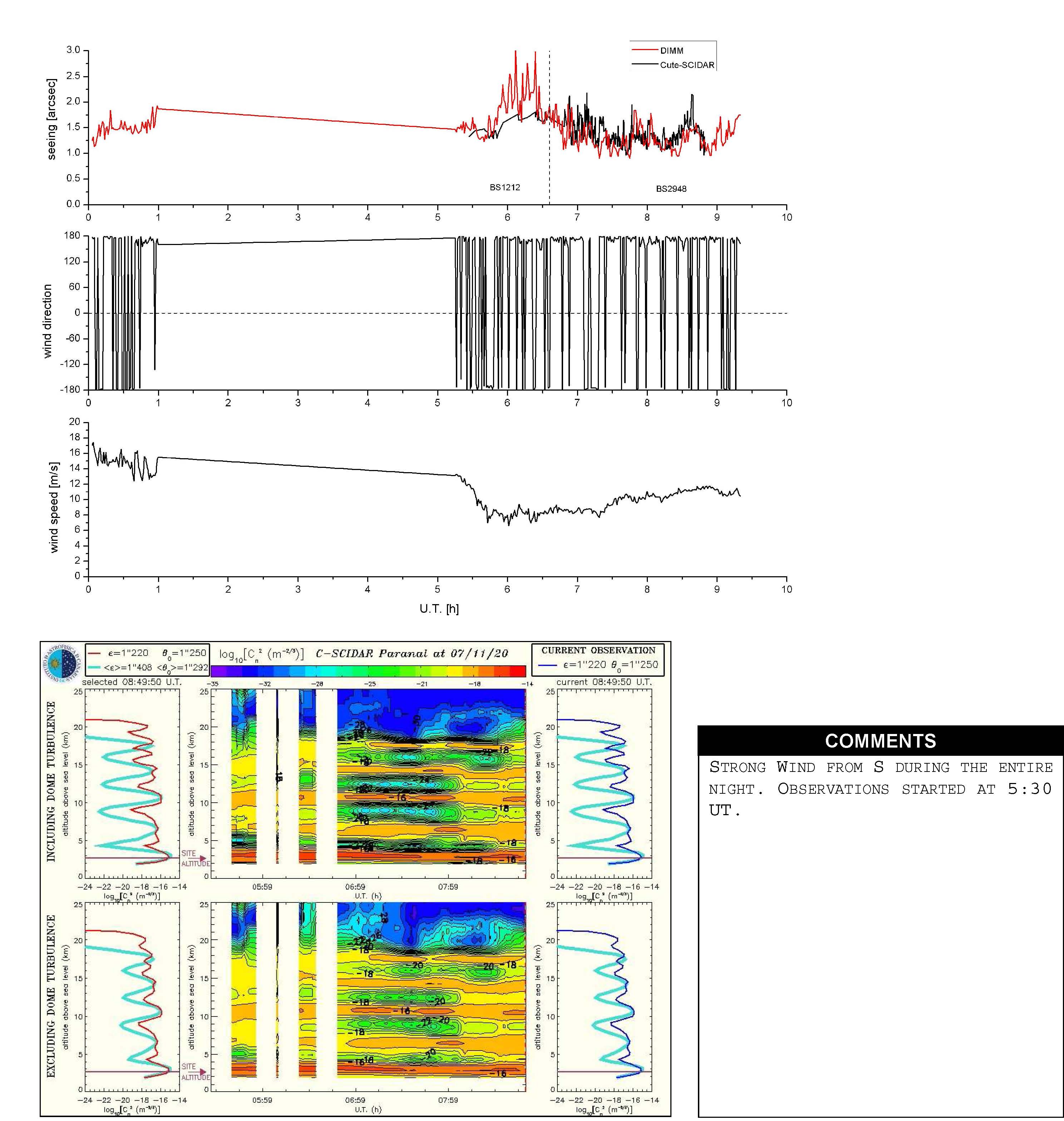

ESO PARANAL CUTE-SCIDAR
|
UT |
|
|
STAR |
|
|
AR |
|
|
DEC |
|
|
MAG 1ST |
|
|
ΔMAG |
|
|
SEP. |
|
|
TEXP |
|
|
CONJ.PL. |
|
|
01:41 – 02:20 |
BS9002 |
23 46 00.8 |
-18 40 41.0 |
5.29 |
1.0 |
|
6″.6 |
3 MS |
3 KM |
|
02:40 – 06:32 |
BS1212 |
03 54 17.4 |
-02 57 17.0 |
4.79 |
1.5 |
|
6″.8 |
3 MS |
3 KM |
|
06:45 – 08:13 |
BS2948 |
07 38 49.3 |
-26 48 07.0 |
4.50 |
0.2 |
|
9″.9 |
1 MS |
3 KM |


ESO PARANAL CUTE-SCIDAR
|
UT |
|
|
STAR |
|
|
AR |
|
|
DEC |
|
|
MAG 1ST |
|
|
ΔMAG |
|
|
SEP. |
|
|
TEXP |
|
|
CONJ.PL. |
|
|
00:53 – 03:20 |
BS0487 |
01 39 47.7 |
-56 11 41.0 |
5.82 |
0.1 |
|
10″.8 |
2 MS |
3 KM |
|
03:31 – 05:45 |
BS0897 |
02 58 15.6 |
-40 18 17.0 |
3.20 |
1.1 |
|
8″.3 |
1 MS |
3 KM |
|
06:09 – 08:30 |
BS2948 |
07 38 49.3 |
-26 48 07.0 |
4.50 |
0.2 |
|
9″.9 |
1 MS |
3 KM |


ESO PARANAL CUTE-SCIDAR
|
UT |
|
|
STAR |
|
|
AR |
|
|
DEC |
|
|
MAG 1ST |
|
|
ΔMAG |
|
|
SEP. |
|
|
TEXP |
|
|
CONJ.PL. |
|
|
02:10 – 04:05 |
BS0897 |
02 58 15.6 |
-40 18 17.0 |
3.20 |
1.1 |
|
8″.3 |
1 MS |
2.5 KM |
|
04:17 – 06:05 |
BS1563 |
04 50 55.1 |
-53 27 41.0 |
5.61 |
0.8 |
|
12″.3 |
2 MS |
2.5 KM |
|
06:20 – 08:46 |
BS2948 |
07 38 49.3 |
-26 48 07.0 |
4.50 |
0.2 |
|
9″.9 |
1 MS |
2.5 KM |
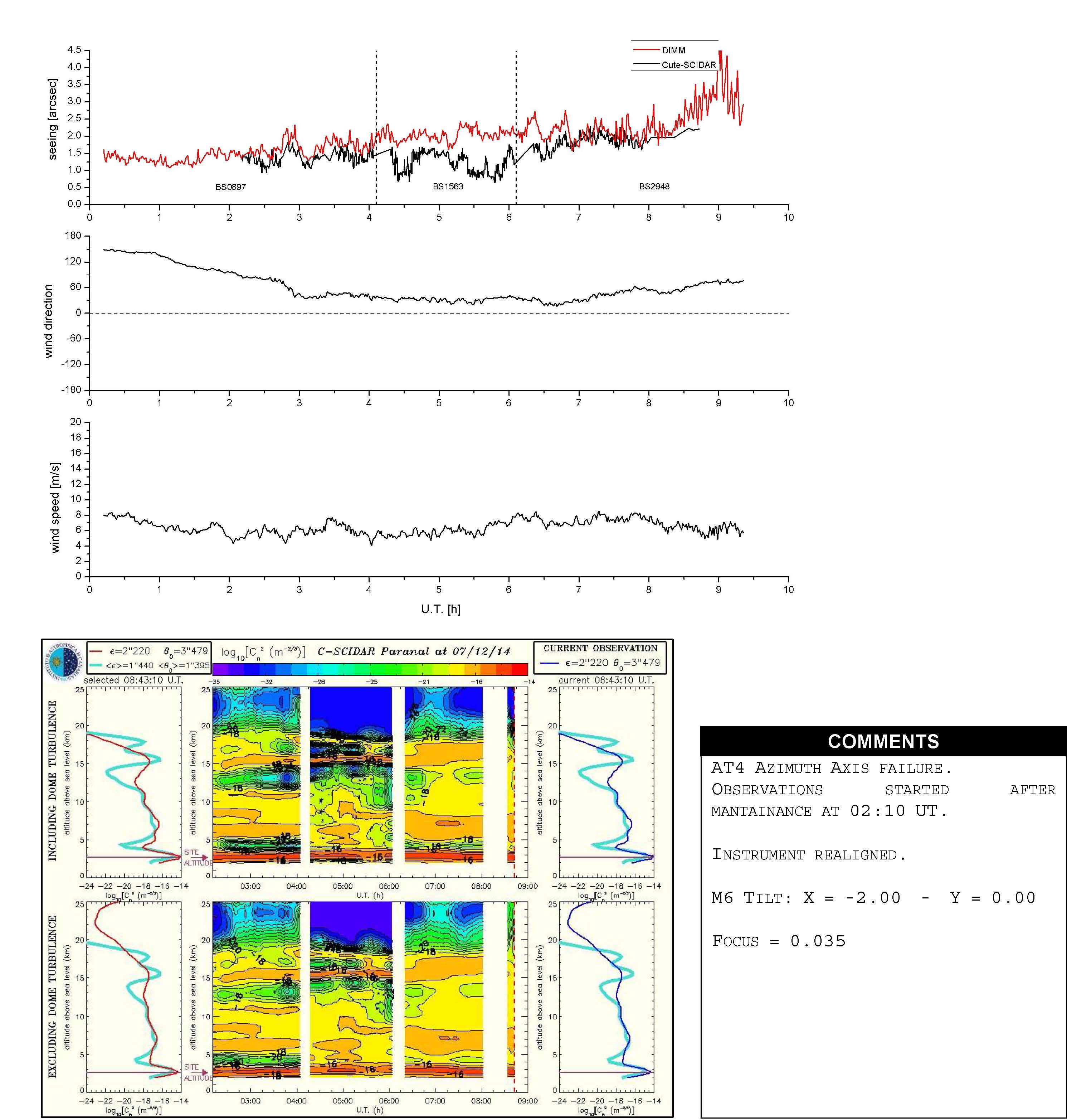

ESO PARANAL CUTE-SCIDAR
|
UT |
|
|
STAR |
|
|
AR |
|
|
DEC |
|
|
MAG 1ST |
|
|
ΔMAG |
|
|
SEP. |
|
|
TEXP |
|
|
CONJ.PL. |
|
|
00:04 – 03:45 |
BS0897 |
02 58 15.6 |
-40 18 17.0 |
3.20 |
1.1 |
|
8″.3 |
1 MS |
2.5 KM |
|
03:57 – 08:10 |
BS2948 |
07 38 49.3 |
-26 48 07.0 |
4.50 |
0.2 |
|
9″.9 |
2 MS |
2.5 KM |


ESO PARANAL CUTE-SCIDAR
|
UT |
|
|
STAR |
|
|
AR |
|
|
DEC |
|
|
MAG 1ST |
|
|
ΔMAG |
|
|
SEP. |
|
|
TEXP |
|
|
CONJ.PL. |
|
|
00:05 – 03:50 |
BS0897 |
02 58 15.6 |
-40 18 17.0 |
3.20 |
1.1 |
|
8″.3 |
1 MS |
2.5 KM |
|
04:01 – 08:20 |
BS2948 |
07 38 49.3 |
-26 48 07.0 |
4.50 |
0.2 |
|
9″.9 |
2 MS |
2.5 KM |
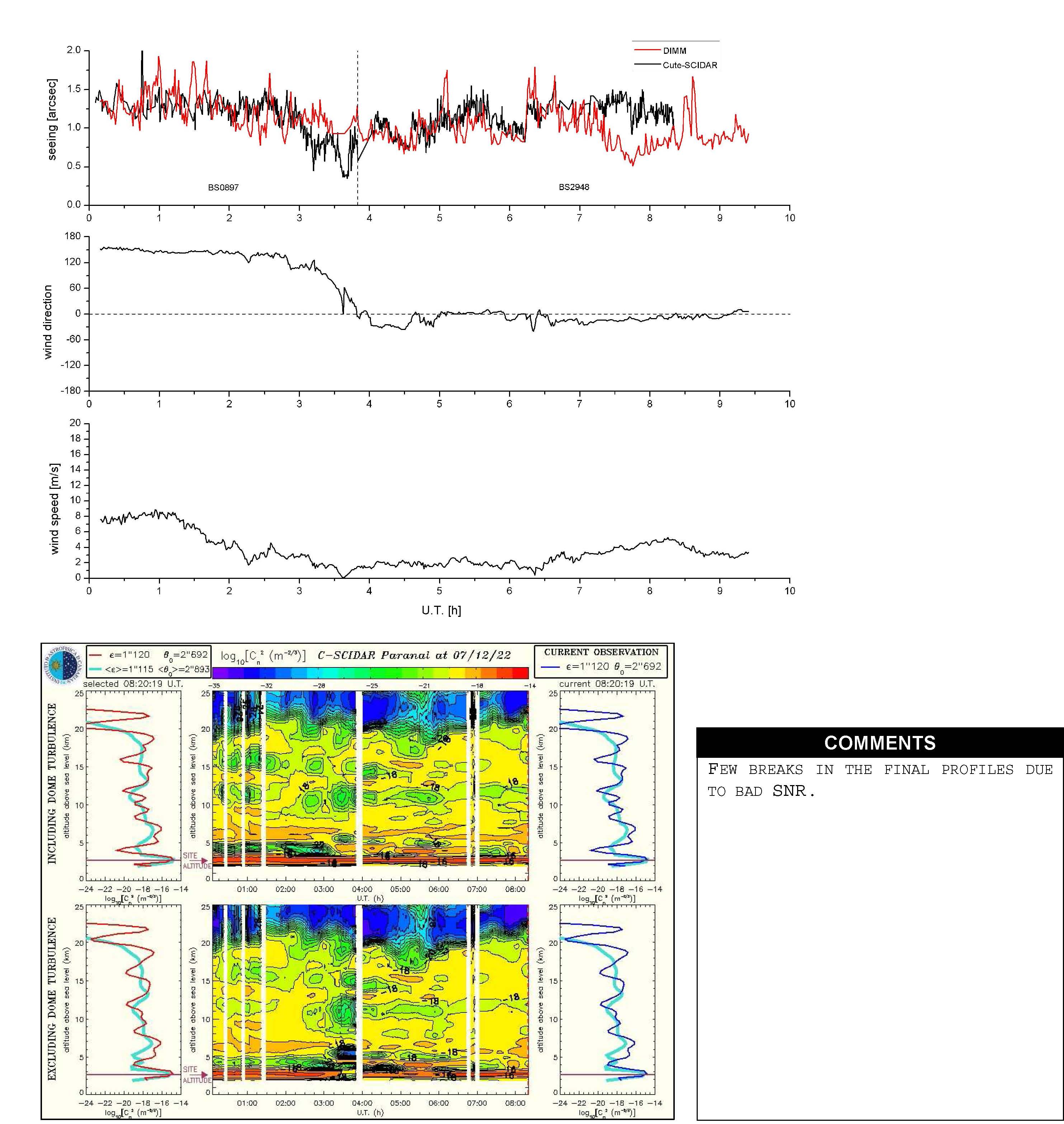

ESO PARANAL CUTE-SCIDAR
|
UT |
|
|
STAR |
|
|
AR |
|
|
DEC |
|
|
MAG 1ST |
|
|
ΔMAG |
|
|
SEP. |
|
|
TEXP |
|
|
CONJ.PL. |
|
|
00:09 – 04:00 |
BS0897 |
02 58 15.6 |
-40 18 17.0 |
3.20 |
1.1 |
|
8″.3 |
1 MS |
2.5 KM |
|
04:10 – 08:30 |
BS2948 |
07 38 49.3 |
-26 48 07.0 |
4.50 |
0.2 |
|
9″.9 |
2 MS |
2.5 KM |
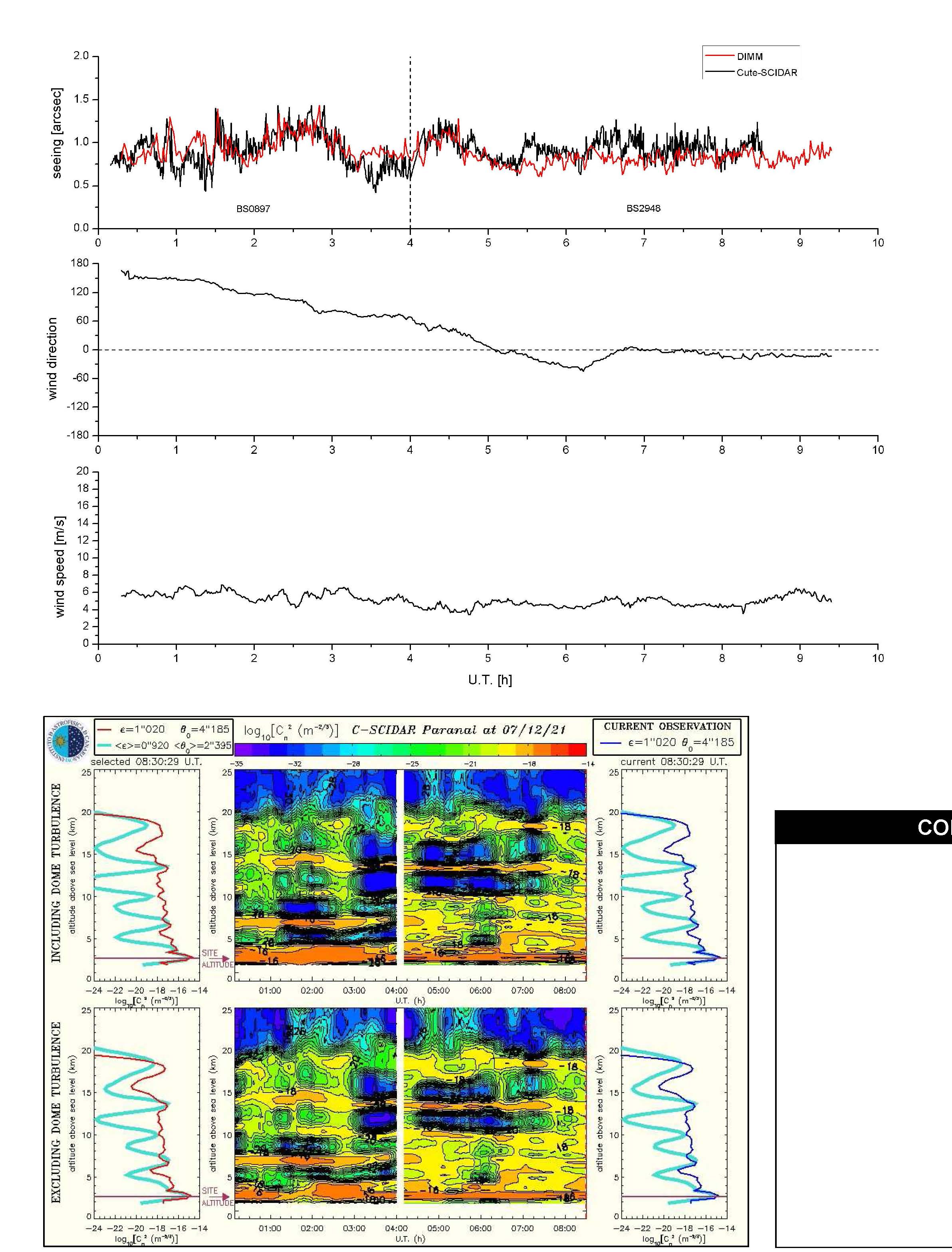


ESO PARANAL CUTE-SCIDAR
|
UT |
|
|
STAR |
|
|
AR |
|
|
DEC |
|
|
MAG 1ST |
|
|
ΔMAG |
|
|
SEP. |
|
|
TEXP |
|
|
CONJ.PL. |
|
|
00:09 – 04:02 |
BS0897 |
02 58 15.6 |
-40 18 17.0 |
3.20 |
1.1 |
|
8″.3 |
1 MS |
2.5 KM |
|
04:12 – 08:30 |
BS2948 |
07 38 49.3 |
-26 48 07.0 |
4.50 |
0.2 |
|
9″.9 |
2 MS |
2.5 KM |



ESO PARANAL CUTE-SCIDAR
|
UT |
|
|
STAR |
|
|
AR |
|
|
DEC |
|
|
MAG 1ST |
|
|
ΔMAG |
|
|
SEP. |
|
|
TEXP |
|
|
CONJ.PL. |
|
|
00:15 – 04:20 |
BS0897 |
02 58 15.6 |
-40 18 17.0 |
3.20 |
1.1 |
|
8″.3 |
1 MS |
2.5 KM |
|
04:30 – 08:30 |
BS2948 |
07 38 49.3 |
-26 48 07.0 |
4.50 |
0.2 |
|
9″.9 |
2 MS |
2.5 KM |
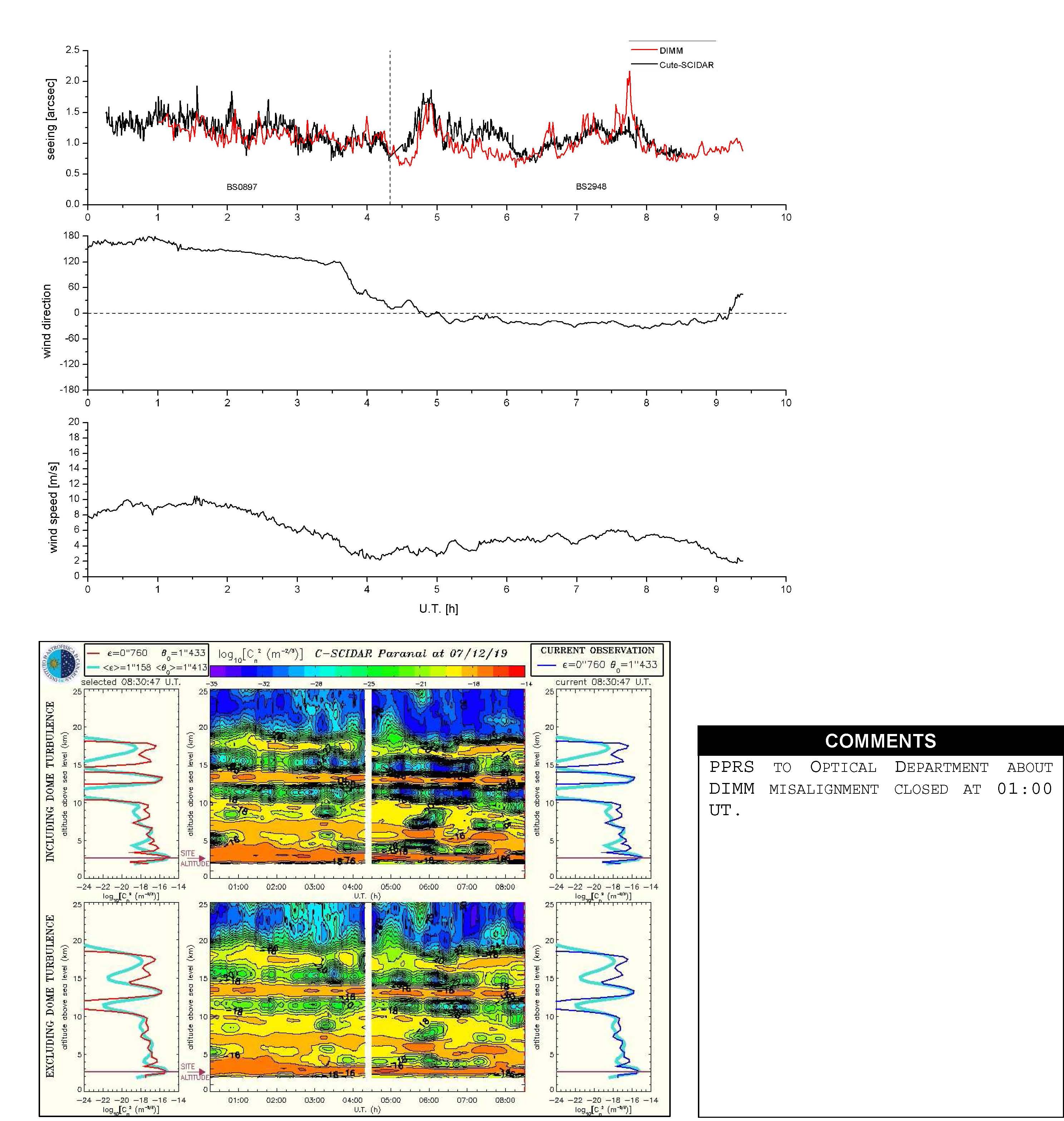

ESO PARANAL CUTE-SCIDAR
|
UT |
|
|
STAR |
|
|
AR |
|
|
DEC |
|
|
MAG 1ST |
|
|
ΔMAG |
|
|
SEP. |
|
|
TEXP |
|
|
CONJ.PL. |
|
|
00:15 – 04:00 |
BS0897 |
02 58 15.6 |
-40 18 17.0 |
3.20 |
1.1 |
|
8″.3 |
1 MS |
2.5 KM |
|
04:17 – 08:30 |
BS2948 |
07 38 49.3 |
-26 48 07.0 |
4.50 |
0.2 |
|
9″.9 |
2 MS |
2.5 KM |


ESO PARANAL CUTE-SCIDAR
|
UT |
|
|
STAR |
|
|
AR |
|
|
DEC |
|
|
MAG 1ST |
|
|
ΔMAG |
|
|
SEP. |
|
|
TEXP |
|
|
CONJ.PL. |
|
|
00:18 – 04:00 |
BS0897 |
02 58 15.6 |
-40 18 17.0 |
3.20 |
1.1 |
|
8″.3 |
1 MS |
2.5 KM |
|
04:37 – 08:30 |
BS2948 |
07 38 49.3 |
-26 48 07.0 |
4.50 |
0.2 |
|
9″.9 |
2 MS |
2.5 KM |
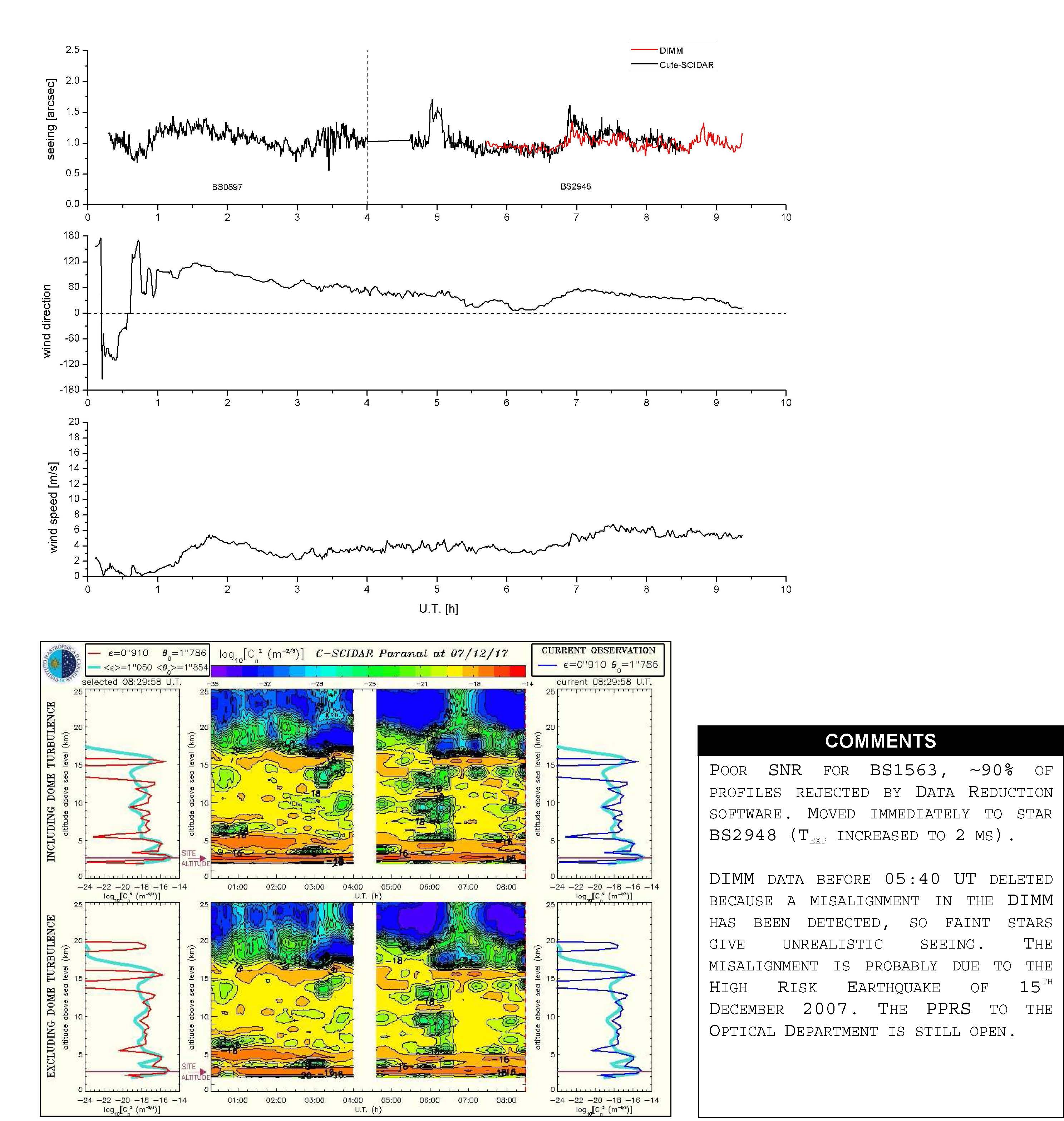

ESO PARANAL CUTE-SCIDAR
|
UT |
|
|
STAR |
|
|
AR |
|
|
DEC |
|
|
MAG 1ST |
|
|
ΔMAG |
|
|
SEP. |
|
|
TEXP |
|
|
CONJ.PL. |
|
|
00:38 – 04:05 |
BS0897 |
02 58 15.6 |
-40 18 17.0 |
3.20 |
1.1 |
|
8″.3 |
1 MS |
2.5 KM |
|
04:14 – 05:30 |
BS1563 |
04 50 55.1 |
-53 27 41.0 |
5.61 |
0.8 |
|
12″.3 |
2 MS |
2.5 KM |
|
05:38 – 08:30 |
BS2948 |
07 38 49.3 |
-26 48 07.0 |
4.50 |
0.2 |
|
9″.9 |
1 MS |
2.5 KM |
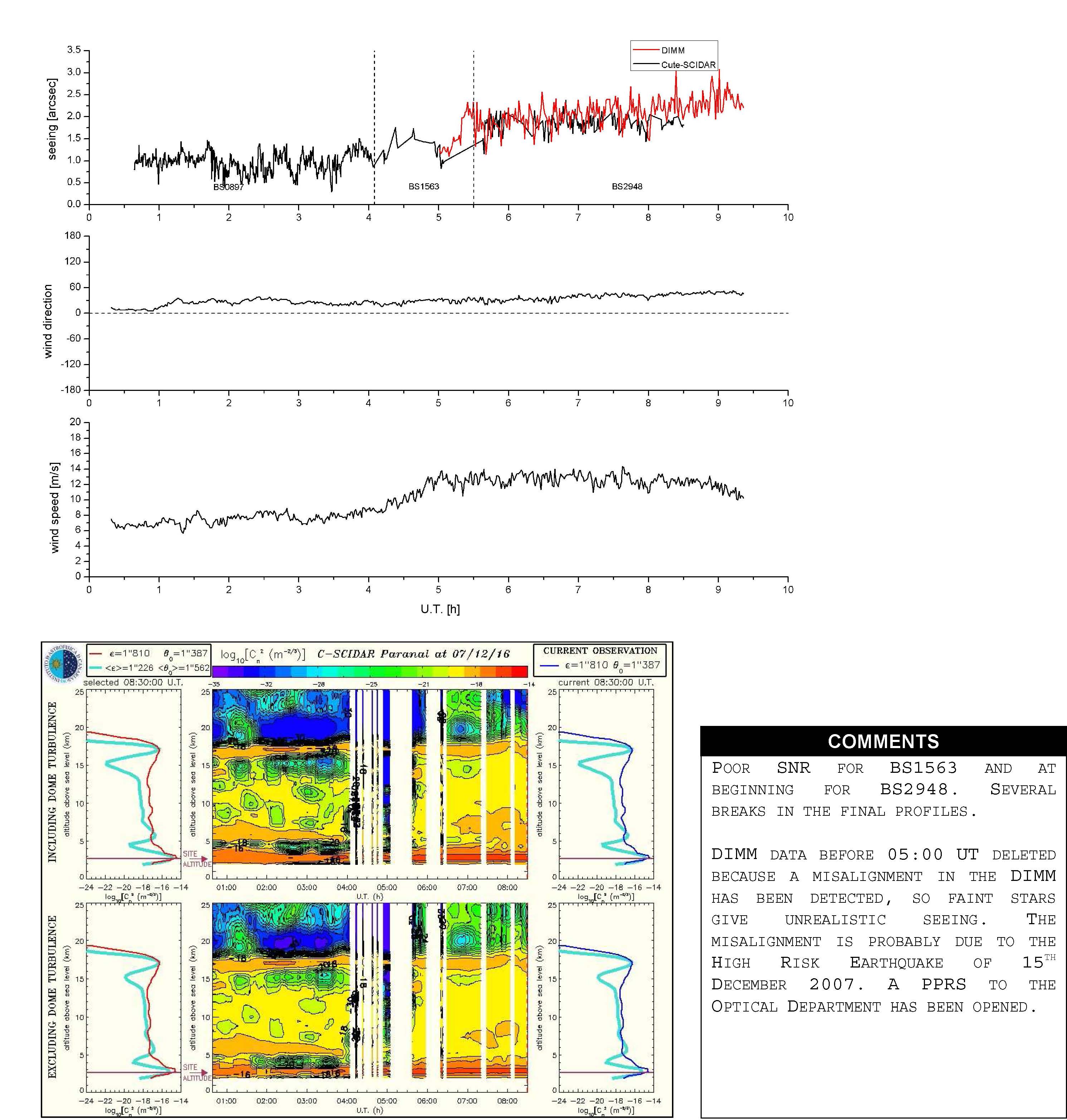

ESO PARANAL CUTE-SCIDAR
NIGHT REPORT
|
UT |
|
|
STAR |
|
|
AR |
|
|
DEC |
|
|
MAG 1ST |
|
|
ΔMAG |
|
|
SEP. |
|
|
TEXP |
|
|
CONJ.PL. |
|
|
00:16 – 04:00 |
BS0897 |
02 58 15.6 |
-40 18 17.0 |
3.20 |
1.1 |
|
8″.3 |
1 MS |
2.5 KM |
|
04:11 – 05:33 |
BS1563 |
04 50 55.1 |
-53 27 41.0 |
5.61 |
0.8 |
|
12″.3 |
2 MS |
2.5 KM |
|
05:47 – 08:10 |
BS2948 |
07 38 49.3 |
-26 48 07.0 |
4.50 |
0.2 |
|
9″.9 |
1 MS |
2.5 KM |












































